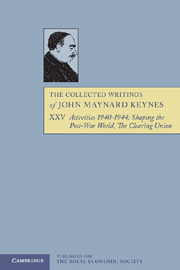Book contents
- Frontmatter
- Contents
- General introduction
- Editorial note
- 1 THE ORIGINS OF THE CLEARING UNION, 1940–1942
- 2 FROM CABINET AGREEMENT TO WHITE PAPER, 1942–1943
- 3 FROM WHITE PAPER TO JOINT STATEMENT, APRIL 1943 TO APRIL 1944
- Appendix 1 Changes from Draft of 4 August 1942 in Version sent to H. D. White on 28 August 1942
- Appendix 2 Changes from Draft sent to H. D. White on 28 August 1942 in the Version sent after the Dominions Discussions, 9 November 1942
- Appendix 3 Changes from the Draft of 9 November 1942 in the White Paper published on 7 April 1943 other than the Preface
- Appendix 4 Joint Statement by Experts on the Establishment of an International Monetary Fund
- List of Documents Reproduced
- Acknowledgements
- Index
1 - THE ORIGINS OF THE CLEARING UNION, 1940–1942
Published online by Cambridge University Press: 05 November 2012
- Frontmatter
- Contents
- General introduction
- Editorial note
- 1 THE ORIGINS OF THE CLEARING UNION, 1940–1942
- 2 FROM CABINET AGREEMENT TO WHITE PAPER, 1942–1943
- 3 FROM WHITE PAPER TO JOINT STATEMENT, APRIL 1943 TO APRIL 1944
- Appendix 1 Changes from Draft of 4 August 1942 in Version sent to H. D. White on 28 August 1942
- Appendix 2 Changes from Draft sent to H. D. White on 28 August 1942 in the Version sent after the Dominions Discussions, 9 November 1942
- Appendix 3 Changes from the Draft of 9 November 1942 in the White Paper published on 7 April 1943 other than the Preface
- Appendix 4 Joint Statement by Experts on the Establishment of an International Monetary Fund
- List of Documents Reproduced
- Acknowledgements
- Index
Summary
The Second World War was not, of course, the first occasion on which Keynes concerned himself with international monetary reform. One need only think of the proposals in A Tract on Monetary Reform (JMK, Vol. IV, pp. 141–60), A Treatise on Money (JMK, Vol. VI, pp. 346–67), ‘Notes on the Currency Question’ (JMK, Vol. XXI) and The Means to Prosperity (JMK, Vol. IX, pp. 355–66).
Apart from occasional discussions with the ‘Old Dogs’ and parts of How to Pay for the War (JMK, Vol. IX), Keynes's first essay on the post-war world came as the result of a request from Harold Nicolson of the Ministry of Information. Nicolson told Keynes that the Ministry was contemplating a campaign to counter Dr Funk's proposals for a German ‘New Order’. He hoped that Keynes would launch the campaign with a broadcast and enclosed notes prepared for the purpose. Keynes replied:
From a letter to H. NICOLSON, 20 November 1940
Dear Harold,
The question you raise in your letter of November 19th wants a good deal of consideration. The following are some preliminary notes on it.
(1) The dossier which you sent along with your letter seems to suggest that we should do well to pose as champions of the pre-war economic status quo and outbid Funk by offering good old 1920–21 or 1930–33, i.e. gold standard or international exchange laissez-faire aggravated by heavy tariffs, unemployment, etc. etc. Is this particularly attractive or good propaganda? If you think it is, I am certainly not the man to put it across.
- Type
- Chapter
- Information
- The Collected Writings of John Maynard Keynes , pp. 1 - 144Publisher: Royal Economic SocietyPrint publication year: 1978
- 1
- Cited by



